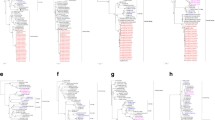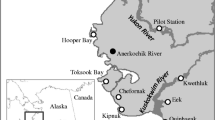Abstract
The Izumi plain in Kagoshima Prefecture, Japan, is an overwintering site of endangered cranes (hooded cranes and white-naped cranes) and of many other migratory birds (including wild ducks) that are considered carriers of avian influenza viruses (AIVs). To assess the risks of a highly pathogenic avian influenza outbreak in the crane populations, we tested various environmental samples for AIVs in this area. In the 2014–2015 winter season, we isolated one AIV of the H6N2 subtype from the cranes’ roost water and two AIVs of the H11N9 subtype from a crane fecal sample and a cloacal swab of a dead spot-billed duck. Genetic analysis of these AIV isolates indicated that our H6N2 isolate is genetically close to AIVs isolated from wild birds in Southeast Asian countries, except that the PB1 and NS genes belong to the North American virus lineage. All genes of the two H11N9 isolates are related to AIVs belonging to the Eurasian virus lineage. Notably, in our phylogenetic trees, H11 HA and N9 NA genes showing high sequence similarity to the corresponding genes of isolates from wild birds in South Africa and Spain, respectively, did not cluster in the major groups with recent wild-bird isolates from East Asia. These results suggest that AIVs with viral gene segments derived from various locations and bird species have been brought to the Izumi plain. These findings imply a possible association of dynamic movements of wild birds with AIV evolution.










Similar content being viewed by others
References
Abed Y, Baz M, Boivin G (2006) Impact of neuraminidase mutations conferring influenza resistance to neuraminidase inhibitors in the N1 and N2 genetic backgrounds. Antivir Ther 11:971–976
Aoki FY, Boivin G, Roberts N (2007) Influenza virus susceptibility and resistance to oseltamivir. Antivir Ther 12:603–616
Berkower I, Smith GE, Giri C, Murphy D (1989) Human immunodeficiency virus 1. Predominance of a group-specific neutralizing epitope that persists despite genetic variation. J Exp Med 170:1681–1695
Capua I, Alexander DJ (2004) Avian influenza: recent developments. Avian Pathol 33:393–404
Downie JC, Laver WG (1973) Isolation of a type A influenza virus from an Australian pelagic bird. Virology 51:259–269
Espeland MA, Murphy WC, Cox C, Billings RJ, Bouwsma OJ (1989) Rerandomization tests for analyzing correlated data from dental studies. Comput Biomed Res 22:1–10
Gabriel G, Dauber B, Wolff T, Planz O, Klenk HD, Stech J (2005) The viral polymerase mediates adaptation of an avian influenza virus to a mammalian host. Proc Natl Acad Sci USA 102:18590–18595
Hatta M, Gao P, Halfmann P, Kawaoka Y (2001) Molecular basis for high virulence of Hong Kong H5N1 influenza A viruses. Science 293:1840–1842
Hay AJ, Zambon MC, Wolstenholme AJ, Skehel JJ, Smith MH (1986) Molecular basis of resistance of influenza A viruses to amantadine. J Antimicrob Chemother 18(Suppl B):19–29
Hoffmann E, Stech J, Guan Y, Webster RG, Perez DR (2001) Universal primer set for the full-length amplification of all influenza A viruses. Arch Virol 146:2275–2289
Lawlor BA, Sunderland T, Hill JL, Mellow AM, Molchan SE, Mueller EA, Jacobsen FM, Murphy DL (1989) Evidence for a decline with age in behavioral responsivity to the serotonin agonist, m-chlorophenylpiperazine, in healthy human subjects. Psychiatry Res 29:1–10
Li Z, Chen H, Jiao P, Deng G, Tian G, Li Y, Hoffmann E, Webster RG, Matsuoka Y, Yu K (2005) Molecular basis of replication of duck H5N1 influenza viruses in a mammalian mouse model. J Virol 79:12058–12064
Maeda Y, Tohya Y, Nakagami Y, Yamashita M, Sugimura T (2001) An occurrence of salmonella infection in cranes at the Izumi Plains, Japan. J Vet Med Sci 63:943–944
Mehle A, Doudna JA (2009) Adaptive strategies of the influenza virus polymerase for replication in humans. Proc Natl Acad Sci USA 106:21312–21316
Murphy GM, Dowd PM, Hudspith BN, Brostoff J, Greaves MW (1989) Local increase in interleukin-1-like activity following UVB irradiation of human skin in vivo. Photo Dermatol 6:268–274
Murphy M, Schenk P, Lankinen HM, Cross AM, Taylor P, Owsianka A, Hope RG, Ludwig H, Marsden HS (1989) Mapping of epitopes on the 65k DNA-binding protein of herpes simplex virus type 1. J Gen Virol 70(Pt 9):2357–2364
Murphy TV, Majewski H (1989) Modulation of noradrenaline release in slices of rat kidney cortex through alpha 1- and alpha 2-adrenoceptors. Eur J Pharmacol 169:285–295
Nera FA, Murphy EL, Gam A, Hanchard B, Figueroa JP, Blattner WA (1989) Antibodies to Strongyloides stercoralis in healthy Jamaican carriers of HTLV-1. N Engl J Med 320:252–253
Okamatsu M, Ozawa M, Soda K, Takakuwa H, Haga A, Hiono T, Matsuu A, Uchida Y, Iwata R, Matsuno K, Kuwahara M, Yabuta T, Usui T, Ito H, Onuma M, Sakoda Y, Saito T, Otsuki K, Ito T, Kida H (2017) Characterization of Highly Pathogenic Avian Influenza Virus A(H5N6), Japan, November 2016. Emerg Infect Dis 23:691–695
Okuya K, Kawabata T, Nagano K, Tsukiyama-Kohara K, Kusumoto I, Takase K, Ozawa M (2015) Isolation and characterization of influenza A viruses from environmental water at an overwintering site of migratory birds in Japan. Arch Virol 160:3037–3052
Okuya K, Kanazawa N, Kanda T, Kuwahara M, Matsuu A, Horie M, Masatani T, Toda S, Ozawa M (2017) Genetic characterization of an avian H4N6 influenza virus isolated from the Izumi plain, Japan. Microbiol Immunol 61:513–518
Ozawa M, Matsuu A, Tokorozaki K, Horie M, Masatani T, Nakagawa H, Okuya K, Kawabata T, Toda S (2015) Genetic diversity of highly pathogenic H5N8 avian influenza viruses at a single overwintering site of migratory birds in Japan, 2014/15. Euro Surveill 20:15–27
Pinto LH, Holsinger LJ, Lamb RA (1992) Influenza virus M2 protein has ion channel activity. Cell 69:517–528
Sakoda Y, Ito H, Uchida Y, Okamatsu M, Yamamoto N, Soda K, Nomura N, Kuribayashi S, Shichinohe S, Sunden Y, Umemura T, Usui T, Ozaki H, Yamaguchi T, Murase T, Ito T, Saito T, Takada A, Kida H (2012) Reintroduction of H5N1 highly pathogenic avian influenza virus by migratory water birds, causing poultry outbreaks in the 2010-2011 winter season in Japan. J Gen Virol 93:541–550
Schmidt JD, Gibbons RP, Bartolucci A, Murphy GP (1989) Prognosis in stage D-1 prostate cancer relative to anatomic sites of nodal metastases. National Prostatic Cancer Treatment Group. Cancer 64:1743–1746
Slemons RD, Johnson DC, Osborn JS, Hayes F (1974) Type-A influenza viruses isolated from wild free-flying ducks in California. Avian Dis 18:119–124
Snyder MH, London WT, Maassab HF, Murphy BR (1989) Attenuation and phenotypic stability of influenza B/Texas/1/84 cold-adapted reassortant virus: studies in hamsters and chimpanzees. J Infect Dis 160:604–610
Spackman E, Stallknecht DE, Slemons RD, Winker K, Suarez DL, Scott M, Swayne DE (2005) Phylogenetic analyses of type A influenza genes in natural reservoir species in North America reveals genetic variation. Virus Res 114:89–100
Subbarao EK, London W, Murphy BR (1993) A single amino acid in the PB2 gene of influenza A virus is a determinant of host range. J Virol 67:1761–1764
Treanor JJ, Snyder MH, London WT, Murphy BR (1989) The B allele of the NS gene of avian influenza viruses, but not the A allele, attenuates a human influenza A virus for squirrel monkeys. Virology 171:1–9
Wang MZ, Tai CY, Mendel DB (2002) Mechanism by which mutations at his274 alter sensitivity of influenza a virus n1 neuraminidase to oseltamivir carboxylate and zanamivir. Antimicrob Agents Chemother 46:3809–3816
Webster RG, Bean WJ, Gorman OT, Chambers TM, Kawaoka Y (1992) Evolution and ecology of influenza A viruses. Microbiol Rev 56:152–179
Webster RG, Bean WJ, Gorman OT, Chambers TM, Kawaoka Y (1992) Evolution and ecology of influenza A viruses. Microbiol Rev 56:152–179
Yamada S, Hatta M, Staker BL, Watanabe S, Imai M, Shinya K, Sakai-Tagawa Y, Ito M, Ozawa M, Watanabe T, Sakabe S, Li C, Kim JH, Myler PJ, Phan I, Raymond A, Smith E, Stacy R, Nidom CA, Lank SM, Wiseman RW, Bimber BN, O’Connor DH, Neumann G, Stewart LJ, Kawaoka Y (2010) Biological and structural characterization of a host-adapting amino acid in influenza virus. PLoS Pathog 6:e1001034
Zohari S, Gyarmati P, Ejdersund A, Berglof U, Thoren P, Ehrenberg M, Czifra G, Belak S, Waldenstrom J, Olsen B, Berg M (2008) Phylogenetic analysis of the non-structural (NS) gene of influenza A viruses isolated from mallards in Northern Europe in 2005. Virol J 5:147
Acknowledgements
This work was supported by grants from the Project of the NARO Bio-oriented Technology Research Advancement Institution (“Integration Research for Agriculture and Interdisciplinary Fields” and “R&D matching funds on the field for Knowledge Integration and Innovation”) and by a grant for the contracted research activity for crane conservation with the City of Izumi, Japan. This research was commissioned by the Kagoshima Crane Conservation Committee.
Author information
Authors and Affiliations
Corresponding author
Ethics declarations
Disclosure of potential conflicts of interest
The authors declare there are no conflicts of interest.
Research involving human participants and/or animals
This research did not involve human participants or animals.
Informed consent
This research did not involve human participants or animals.
Additional information
Handling Editor: Ayato Takada.
Rights and permissions
About this article
Cite this article
Nakagawa, H., Okuya, K., Kawabata, T. et al. Genetic characterization of low-pathogenic avian influenza viruses isolated on the Izumi plain in Japan: possible association of dynamic movements of wild birds with AIV evolution. Arch Virol 163, 911–923 (2018). https://doi.org/10.1007/s00705-017-3698-1
Received:
Accepted:
Published:
Issue Date:
DOI: https://doi.org/10.1007/s00705-017-3698-1




